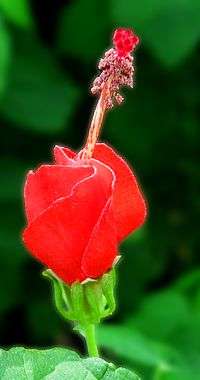Malvaviscus arboreus
Malvaviscus arboreus is a species of flowering plant in the hibiscus family, Malvaceae,[1] that is native to the Southeastern United States,[2] Mexico, Central America, and South America. The specific name, arboreus, refers to the tree-like appearance of a mature plant. It is now popular in cultivation[3] and goes by many English names including Turkcap, Turk's turban, wax mallow, ladies teardrop and Scotchman's purse. Its flowers do not open fully and help attract butterflies and hummingbirds.
| Malvaviscus arboreus | |
|---|---|
 | |
| Scientific classification | |
| Kingdom: | Plantae |
| Clade: | Tracheophytes |
| Clade: | Angiosperms |
| Clade: | Eudicots |
| Clade: | Rosids |
| Order: | Malvales |
| Family: | Malvaceae |
| Genus: | Malvaviscus |
| Species: | M. arboreus |
| Binomial name | |
| Malvaviscus arboreus | |
| Varieties | |
|
See text | |
| Synonyms[1] | |
| |
Distribution
Malvaviscus arboreus is native to Central America, Mexico, and the Gulf Coast of the United States, particularly as an understory shrub in coastal Texas and Louisiana.[4]
Habitat and ecology

Malvaviscus arboreus is a common understory shrub where it occurs in Texas and is an important food source for female and juvenile Ruby-throated Hummingbirds (Archilochus colubri) and Black-chinned Hummingbirds (A. alexandri). Each individual flower lasts two days but contains more nectar on the first day.[5]
An example occurrence of M. arboreus is within the coastal Petenes mangroves of the Yucatán region of Mexico, in which plant community it is a subdominant species.[6] M. arboreus is the primary host plant for the caterpillars of the Turk's-cap White-Skipper (Heliopetes macaira).[7]
Cultivation
Malvaviscus arboreus is commonly cultivated in shady to sunny sites in butterfly and hummingbird gardens across the southern United States. It can be propagated from fresh seeds or from softwood cuttings. It often blooms from May through November, but will bloom throughout a mild winter.[8]
Varieties
- Malvaviscus arboreus var. arboreus
- Malvaviscus arboreus var. drummondii (Torr. & A.Gray) Schery (= Malvaviscus drummondii Torr. & A.Gray)[9]
- Malvaviscus arboreus var. mexicanus Schltdl.[10]
References
- "Malvaviscus arboreus". Germplasm Resources Information Network (GRIN). Agricultural Research Service (ARS), United States Department of Agriculture (USDA). Retrieved 2010-03-23.
- "Malvaviscus arboreus Dill. ex Cav. wax mallow". PLANTS Database. United States Department of Agriculture. Retrieved 2009-12-16.
- Clay, Horace F.; James C. Hubbard (1987). Tropical Shrubs. University of Hawaii Press. p. 104. ISBN 978-0-8248-1128-0.
- Turner, Billie L.; Mendenhall, Meghan G. (1993). "A Revision of Malvaviscus (Malvaceae)" (PDF). Annals of the Missouri Botanical Garden. 80 (2): 439–457. doi:10.2307/2399792. ISSN 0026-6493. JSTOR 2399792.
- George, Mary Wissink (October 1980). "Hummingbird foraging behavior at Malvaviscus arboreus var. drummondii" (PDF). The Auk. 97: 790–794 – via Searchable Ornithological Research Archive.
- World Wildlife Fund. eds. Mark McGinley, C.Michael Hogan & C. Cleveland. 2010. Petenes mangroves. Encyclopedia of Earth. National Council for Science and the Environment. Washington DC Archived 2011-10-15 at the Wayback Machine
- "Turk's-cap White-Skipper Heliopetes macaira (Reakirt, [1867])". Butterflies and Moths of North America. Archived from the original on 2010-06-20. Retrieved 2010-08-22.
- "Lady Bird Johnson Wildflower Center - The University of Texas at Austin". www.wildflower.org. Retrieved 2019-03-27.
- "Malvaviscus arboreus var. drummondii". Germplasm Resources Information Network (GRIN). Agricultural Research Service (ARS), United States Department of Agriculture (USDA). Retrieved 2010-03-23.
- "Malvaviscus arboreus var. mexicanus". Germplasm Resources Information Network (GRIN). Agricultural Research Service (ARS), United States Department of Agriculture (USDA). Retrieved 2010-03-23.
![]()
![]()